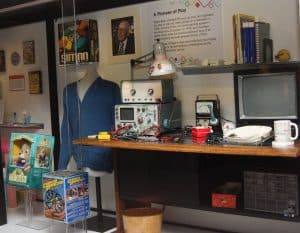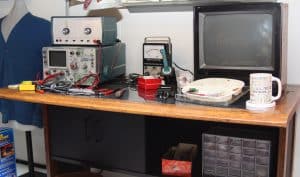 Museums have long memorialized genius. While art museums preserve great paintings and sculptures, history museums collect and preserve a wide-ranging record of the ways individuals, groups, and companies have shaped our society. The Strong’s focus on the history and meaning of play has guided its efforts to preserve a comprehensive collection of artifacts that document the rich history of toys, dolls, games, puzzles, electronic games, and other playthings. Among these collections are those donated by Ralph Baer, who over the course of his life transformed the way people play. That’s why The Strong is pleased to have installed a display of Ralph’s desk and work area from his Florida home, where he did much of his inventing.
Museums have long memorialized genius. While art museums preserve great paintings and sculptures, history museums collect and preserve a wide-ranging record of the ways individuals, groups, and companies have shaped our society. The Strong’s focus on the history and meaning of play has guided its efforts to preserve a comprehensive collection of artifacts that document the rich history of toys, dolls, games, puzzles, electronic games, and other playthings. Among these collections are those donated by Ralph Baer, who over the course of his life transformed the way people play. That’s why The Strong is pleased to have installed a display of Ralph’s desk and work area from his Florida home, where he did much of his inventing.
Over the last 10 years of his life, Ralph gave The Strong thousands of personal papers and artifacts that document his long career of inventing a wide range of electronic playthings. In 1966, Ralph originated the idea of playing a video game on a home television—a brainstorm that led to a patent on the process and then the successful development of the first home video game system, the Magnavox Odyssey (1972). When The Strong opened its eGameRevolution exhibit in 2010, Ralph gave us a working reproduction of his prototype for the system and then, in one of his several visits here, he traveled to the museum and our International Center for the History of Electronic Games (ICHEG) to celebrate its installation.
 After introducing home video games, Ralph kept inventing and developed the first military use of a video game and numerous electronic playthings. His most famous electronic game is the memory-challenging handheld toy, Simon. Released in 1978, it soared to popularity because of its intuitive design, appealing colors and sounds, and its resemblance in shape to the flying saucers of the cult classic film Close Encounters of the Third Kind. Its success prompted toymakers to release many other portable electronic devices, and Ralph himself invented dozens of products, some of which became successful toys, such as Computer Perfection, Maniac, and Amazatron. Simon remains a popular seller even today, nearly four decades after its release.
After introducing home video games, Ralph kept inventing and developed the first military use of a video game and numerous electronic playthings. His most famous electronic game is the memory-challenging handheld toy, Simon. Released in 1978, it soared to popularity because of its intuitive design, appealing colors and sounds, and its resemblance in shape to the flying saucers of the cult classic film Close Encounters of the Third Kind. Its success prompted toymakers to release many other portable electronic devices, and Ralph himself invented dozens of products, some of which became successful toys, such as Computer Perfection, Maniac, and Amazatron. Simon remains a popular seller even today, nearly four decades after its release.
The papers that Ralph donated to The Strong reveal a timeline of his work. They show a man with a restlessly inventive mind who carefully recorded his brainstorms, organized them meticulously, and succeeded in the difficult task of transforming ideas into final products. Over the years, he collaborated widely with numerous other toy inventors, many of whom lived in Florida near his home, where he liked to spend the winters.
 The Strong is pleased to display the workspace from Ralph’s Florida home, complete with many of the tools of his trade. His soldering gun, oscilloscope, ohm meter, and drawers of electronic components remind anyone who knew him of how skillfully his hands could contrive what his mind conceived. Even at the end of his life, Ralph was still inventing. The last time I saw him, about two months before his death, he took me into his office and showed me a toy he was working on—a pizza that spun around and invited kids to try and place pieces on it. He smiled as he connected the wires and set the toy in motion. “Don’t you think kids will like this,” he not so much asked as stated. Ralph was in his 90s, but his fertile mind had not stopped, and he still knew fun when he made it. ICHEG is pleased that guests—young and old—who visit The Strong’s eGameRevolution exhibit will see the work area of this man of genius and appreciate anew his gift of play.
The Strong is pleased to display the workspace from Ralph’s Florida home, complete with many of the tools of his trade. His soldering gun, oscilloscope, ohm meter, and drawers of electronic components remind anyone who knew him of how skillfully his hands could contrive what his mind conceived. Even at the end of his life, Ralph was still inventing. The last time I saw him, about two months before his death, he took me into his office and showed me a toy he was working on—a pizza that spun around and invited kids to try and place pieces on it. He smiled as he connected the wires and set the toy in motion. “Don’t you think kids will like this,” he not so much asked as stated. Ralph was in his 90s, but his fertile mind had not stopped, and he still knew fun when he made it. ICHEG is pleased that guests—young and old—who visit The Strong’s eGameRevolution exhibit will see the work area of this man of genius and appreciate anew his gift of play.
By Jon-Paul Dyson, Director, International Center for the History of Electronic Games and Vice President for Exhibits
 Hours 10 a.m.–5 p.m. | Fri. & Sat. till 8 p.m.
Hours 10 a.m.–5 p.m. | Fri. & Sat. till 8 p.m.